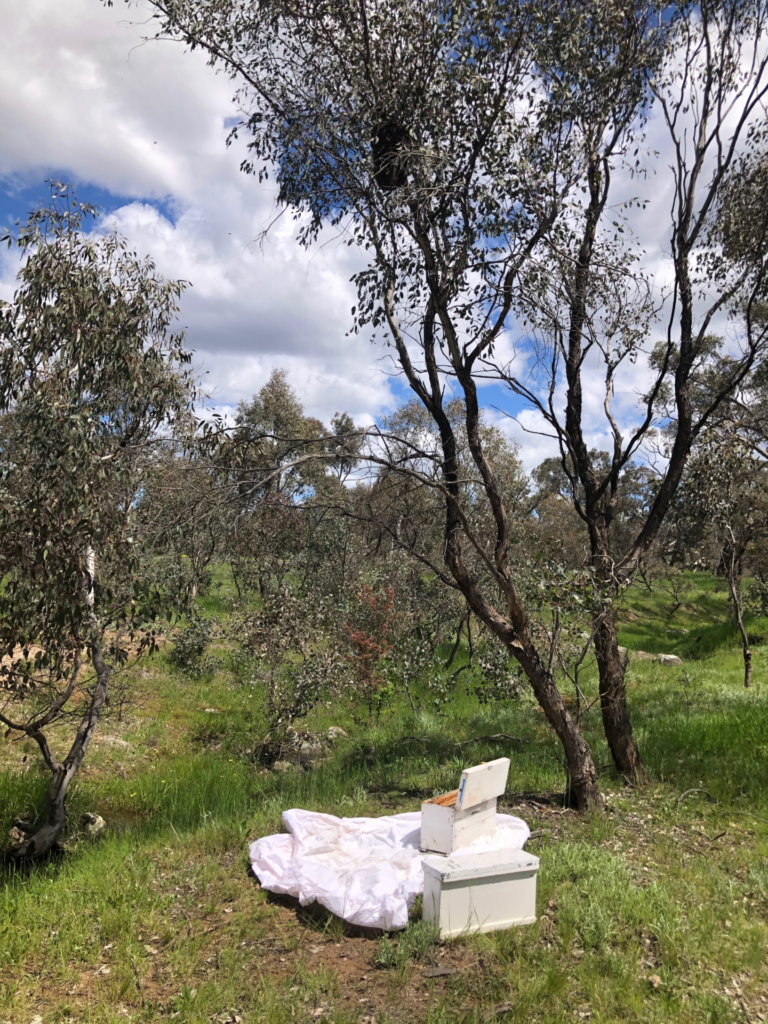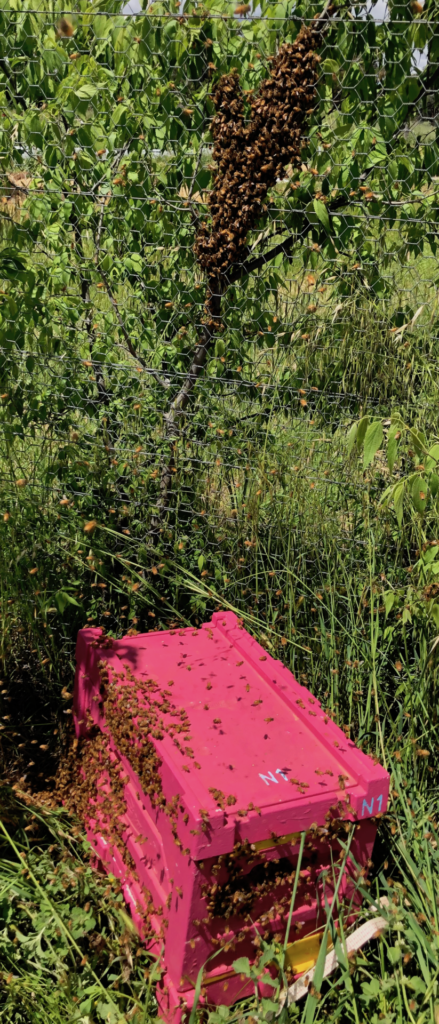Alan Wade
When warming to swarming becomes an overheated warning
Of the fifty or so hives I’ve checked this season of ‘bees on steroids’, most had either swarmed or had prepared to do so. Of the remaining ‘normal colonies’, nearly all were headed by replacement queens or were in the process of putting a new queen in themselves. We call this very latter and orderly process ‘supersedure’. It is signalled by very few (typically less than five) queen cells present, and most often found in or near the centre of the brood nest.
It’s pretty important to be able to read whether your bees are about to swarm or about just replacing their colony queen. If bees are about to swarm, or might do so, bees will stop gathering nectar, the queen will stop laying (to enable her to fly) and the workers will cease building comb. So culling many, maybe all, queen cells won’t remove the swarming impulse and urgent action is needed to turn them away from swarming. If, on the other hand, the bees are simply intent on queen replacement let them do so as they really do need to replace their failing queen.
Either way removing queen cells won’t prevent them starting over again, well not until the swarming season is over or that underperforming queen is replaced. Until you take really decisive action to stop swarming, or to replace that poor queen, your efforts to build your bees for an early honey flow will be a matter of action too little, too late.

John Hogg clearly delineated supersedure and swarmingi:
Queen supersedure is never the cause of swarming. But supersedure may occur concurrently with the swarm whenever the queen’s failure was caused by being over-taxed while generating the bees for that swarm. Significantly, it is the virgin queen that is then selected to accompany the swarm. The failed queen is retained in the parent hive to be superseded in turn…
While it may not seem obvious, heading off swarming or intervening once bees become crowded is much easier that you may think. The simple measures adopted by commercial beekeepers, and that have successfully kept my bees together for many years, are discussed elsewhereii.
Requeening plans
You need plenty of bees to get lots of honey and – if my logic hasn’t quite deserted me – I’d prefer to see the honey in the pantry than dripping from an irate neighbour’s ceiling resulting from my bees swarming effort. Bees preoccupied with swarming or managing a queen on her last legs are not the recipe for good beekeeping practice.
So apart from splitting hives, supplying room in brood nests and for bees to cure nectar and store honey, all to head off swarming, I and a handful of club members have just dropped forty five queens into hives and then mainly into small colonies we call nucs or splits. This strategy overcomes the propensity of colonies with queens anything more than 18 months of age to swarm twice as much as colonies with brand new queens. Our plans were in place in March and April of this year: well that is when we put in our queen order.

Decisive action in the aftermath of swarming
If swarming has left you with remnant colonies, some even queenless, you can still requeen themiii and hope that your bees can build to get through the winter of 2021. In this sad scenario don’t expect this season to give you rivers of honey. Even finding a queen supplier – I’m not one – may now be a further challenge. If all else fails the best strategy is to unite colonies and simply split of newbies when queens are available.
Step 1 Wait till any colonies you’ve found to be preparing for swarming, or have split to actually stop them swarming, have settled and have successfully requeened themselves.
Requeening colonies in the process of swarming is fraught with danger as we found in one club colony we inspected recently. A quick check of frame bottom bars showed it had plenty of swarm queen cells both sealed and recently emerged. In just one of two brood boxes we found and marked two virgin queens – there were probably more – but we left them to sort themselves out.
Step 2 As we had new queens arriving we did something very simple. We removed a strong nucleus colony from one colony about to swarm, taking great care to ensure that no virgin queens or queen cells were transferred. We then put a new queen into this offset colony and added drawn comb and foundation to the parent colony. This was a quick fix measure designed to get the parent colony to abandon its swarming effort. Meanwhile we had established a young queen elsewhere ready to give the colony a fresh start 3-4 weeks later.
And down the track
To help redeem the super swarming event, we plan a backup autumn requeening program, something I’ve always advocated but always been found wanting in execution. So we’ve put in a late March 2021 queen order as I don’t have a good breeder queen or a large enough apiary to run drone mother colonies to justify raising more than a few queens myself.
You might do the same yourself, that is skill up and raise some queens or put in an order now. There are several bee gear supply agents who supply queens and a few reputable local queen producers such as Snowgum Apiaries. Otherwise simply check out The Australasian Beekeeper (or for that matter Dr Google) for online queen suppliers, ring around and place an order as you would do to buy a new washing machine.
Autumn requeening
The case for requeening in autumn is a subject of neglect. Good queens are generally best raised in spring and autumn, well at least in south eastern Australia. Early spring requeening, conducted while colonies are small and easy to handle and before the onset of the swarming season, may seem desirable. However, in practice, good queens are really only readily available (unless purchased from sub tropical breeders) from mid-to-late spring and but even later if you fail to order way ahead of time. The alternative, early autumn requeening – when queens are more readily available – obviates these problems.
Autumn requeening, including running spare queens in strong insulated (ideally six-frame) nucleus colonies, is not widely appreciated. Since queens introduced in autumn age very slowly over winter – they are not under laying stress – they commence laying earlier than previous season’s summer queens and their colonies are far less swarm prone than colonies headed by older queens.
So requeening in autumn rather than spring is a not a heart over mind matter. The enthusiasm for beekeeping in spring versus the decline in interest and increased propensity to get get stung in autumn makes spring requeening the natural choice for the enthusiastic and perhaps naïve beginner. Simple logic suggests that autumn requeening and having spare young queens at spring startup may be less silly than it sounds. Vote requeening now and requeening often.
iHogg, J.A. (2006). Colony level honey bee production: The anatomy of reproductive swarming. American Bee Journal 146(2):131-135. http://www.twilightmd.com/Samples/Hogg/Hogg_Halfcomb___Publications/ABJ_2006_February.pdf
iiWade, A (August 2018). A Simple Swarm Control Guide Part I. https://actbeekeepers.asn.au/bee-buzz-box-august-2018/
Wade, A (August 2018). A Simple Swarm Control Guide Part II. https://actbeekeepers.asn.au/bee-buzz-box-august-september-part-ii/
iiiCannon, D. (October 2020). Saving a failing hive. The Australasian Beekeeper 122(4):30-32.

Be the first to comment